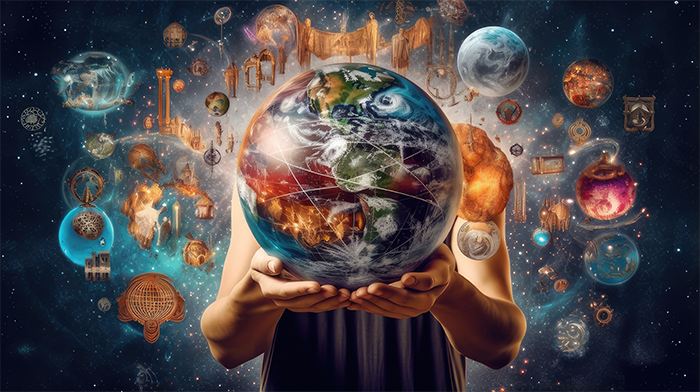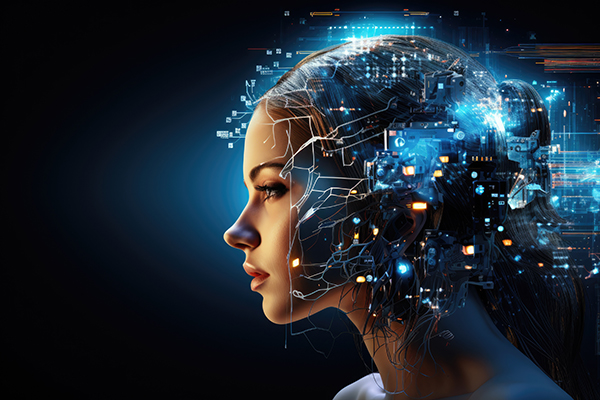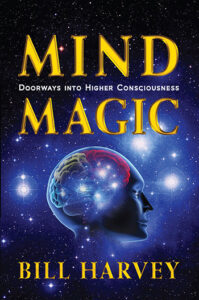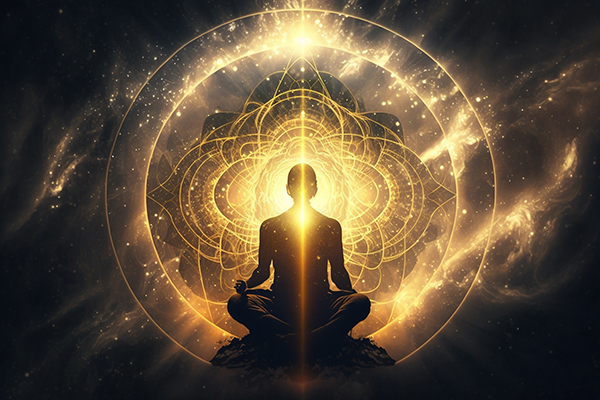Welcome to this week’s Bill Harvey Blog, January 10, 2025
Created February 2, 2024

Not to contradict the Bard’s “All the World’s a Stage” – both lenses make sense. The value of using lenses experimentally is that you see things in new ways. This both stretches and searches your imagination.
Einstein said that imagination was even more important to him than intellect, and he demonstrated the power of imagination in his thought experiments methodology, without which we might to this day not know about relativity.
Hopefully, you have in my earlier writings picked up my notion that there is probably a scientific explanation for the actual existence of God. My own lens (which I now have come to strongly suspect is the truth) is that all that exists is a single consciousness of which we are individualized manifestations.
In A Theory of Everything Including Consciousness and God, I support this hypothesis within the current physics standard model, positing that John Wheeler’s quantum foam might be identical with consciousness.
If the truth is anywhere in that neighborhood, what is consciousness doing here on Earth, why is our history the way it is, why are we facing the perils we today are facing?
If one looks for the Good, and asks how can the turmoil and terror we are now undergoing be a good thing, the answer is that it might be the only way for us to learn lessons we desperately need to learn.
It is common to observe that a person who is spiraling downward often cannot reverse course until he or she hits bottom. This has oft been observed for example in the case of alcoholics.
Perhaps we have become so addicted culturally to ego and its demands that the only cure is to let it take its painful course. Money and power have over the millennia been concentrated in a small fraction of us. Today, some of those people have decided to use their money and power for Good, while the vast majority still are hypnotized by greed and narcissism.
The vast majority worry about the future and have become cynical. Merriam-Webster defines “cynicism” as “the sneering disbelief in sincerity or integrity”. This means literally that the average person believes that no one has sincerity or integrity and if they do, they’re a fool.
What if the meaning and purpose of life on Earth is that we are here to learn about life, about reality, our place in it, and what to do about it, how to fit in cosmically, and perhaps how to be trustworthy enough to be reborn in an even more powerful body and mind, possibly at a higher level of evolution?
This cannot be tossed aside as a ridiculous idea. It could be what is actually going on.
What can we do more of than anything else? Learn, perhaps? Each day, each second, there is something to learn from the situation we are in. Possibly a lens might tend to be more useful the more that lens can help us notice learning opportunities and think deeply, and feel deeply around inside, about these learning opportunities.
All of the turbulence in our minds is in its own buckshot way a groping, distracted, grasping at straws attempt to figure out stuff. How do we apologize, how do we keep this job, how do we cure this ill, how do we repair this damage, what should we do first. We may not be successful at it, but it does appear to be some sort of effort to learn something.
All species appear to share curiosity and play, both of which are key parts of a learning process.
Where we went wrong as a race is we learned how to take more than our share and then unintentionally idealized that as the summum bonum. The highest good.
Hence a world fixated on competition rather than cooperation. A world that increasingly disbelieves in the Good.
Is Earth where souls from everywhere who got left back got sent for remedial education?
Or does it just seem that way from the news and social media babble?
As we navigate amongst each other each day we encounter friendly folks making jokes and standing up to the slings and arrows of outrageous fortune. 99% of what we experience in an average day is Good. Unless we are spending too much time imbibing doom and gloom from pitiless media choices.
A lens of seeing the Good, looking for it whenever it seems to be absent, asking what could a possible single consciousness be doing here for us to doubt the justification for suffering in today’s world, such a lens enables us to divine what the Divine might be thinking.
We ourselves have conscious choices to make as to what learning we welcome the most, what lessons we wish to draw upon ourselves. We can choose not to suffer. It actually works when one uses the powers of concentration which lie perhaps dormant from long disuse within us. We can choose to release the tensions in our bodies, to see and feel the Good in our lives in the present moment, to take in and savor the beauty around us, to focus on taking the Good to others, sharing Good as widely as possible, learning step by patient step how to become better at it.
We need to learn that negativity cannot serve the Good.
Love to all,
![]()


 “When you are about to see something, your mind automatically searches your memory for a comparable object (note the distinction between you seeing something and your mind having already seen it). If your mind finds something similar enough, it projects the stored image onto the new object so that you do not ever see the new object, but are merely dimly aware that there is a familiar type of object there… As a result of this, you mostly do not perceive your environment, instead perceiving mostly what you expect to perceive, i.e. you usually see your mind’s prediction.”
“When you are about to see something, your mind automatically searches your memory for a comparable object (note the distinction between you seeing something and your mind having already seen it). If your mind finds something similar enough, it projects the stored image onto the new object so that you do not ever see the new object, but are merely dimly aware that there is a familiar type of object there… As a result of this, you mostly do not perceive your environment, instead perceiving mostly what you expect to perceive, i.e. you usually see your mind’s prediction.”
